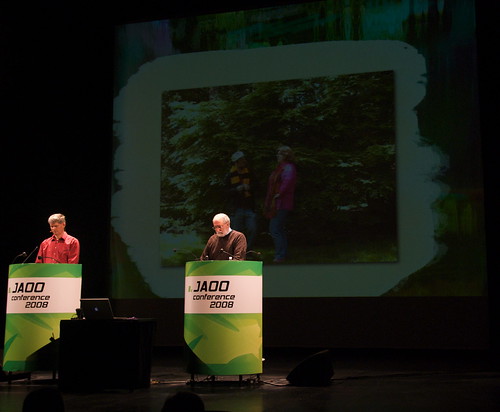How (Not) to Build a Metaverse
Wed 05 October 2022 by Jim PurbrickEarlier in the year I helped Josh Sanburn and his team put together a podcast series on building Second Life for the Wall Street Journal called “How To Build a Metaverse” which I’m now really enjoying. It’s great to hear all of the amazing stories about the origin of Second Life told by some of the most amazing people I’ve ever worked with, but the stories I’m enjoying the most are the stories I hadn’t heard before.
An incredible example from the most recent episode is the story of how Second Life’s moderation began. Peter Alau tells the tale of how he cribbed together a 20 paragraph Terms of Service using examples from other virtual worlds before Philip stepped in and mandated that the terms of service should be “Be Nice”.
My life was changed forever when I read Julian Dibbell’s article “A Rape In Cyberspace” while working on the literature review for my PhD in Persistent Virtual Environments at the University of Nottingham. The article made me realize that virtual worlds were not just a collection of interesting technical challenges, but that they could become real, meaningful communities and that the people who met in them could be hurt, just as they can in real life. Reading Dibbell’s article made me want to work on commercial virtual worlds that enabled those real human communities rather than experimental worlds that only existed as technical proofs of concept. I left academia, started working in the games industry, and quickly found the Terra Nova group blog that Julian Dibbell was contributing to along with Cory Ondrejka, the CTO of Linden Lab.
Given the path that led me to Second Life, I was saddened to hear that the origin story of moderation in Second Life didn’t mention it. Peter should have known that people wouldn’t read his epic Terms of Service, but at least he tried to apply best practice. “A Rape In Cyberspace” was already 10 years old when Second Life launched and Linden Lab were talking to many of the pioneers who worked on early virtual worlds. Philip should have known better, but pursued a wishful, naive approach to moderation and Second Life ended up learning a lot of lessons that had already been learned the hard way.
This wasn’t the only occasion that Second Life’s design was optimistic, naive and didn’t give enough thought to how it might be abused by bad actors. When I first visited San Francisco I hosted a party on Russian Hill to get to know my colleagues only to end up huddled in the living room with other engineers battling a plague of grey goo spreading across the grid that was enabled by an over-permissive API. The API allowed scripted objects to self-replicate and so exponentially overwhelm regions until firewalls of shut down simulators limited the spread and space lasers were able to delete scripts to purge the world of the menace. Shortly after I returned to the UK I woke up one morning to my first encounter with the infamous Goatse image which a resident had pasted across the world so that it would show up on the live map that had been naively been added to the front page of secondlife.com without enough thought about how it might be abused.
Eventually Second Life’s moderation policies and processes got to a good place (Robin Harper was one of the people I spoke to about best practices for moderation when I was working on building safety into Oculus Venues) but the story of how moderation began in Second Life is one of missed opportunities. We shouldn’t just laugh off Second Life’s failings as the stories of swashbuckling hackers while at the same time pointing fingers at the similar failings of the current efforts to build a Metaverse. Multi-user virtual worlds were already 20 years old when Second Life was built and many lessons had already been learned.
“How To Build a Metaverse” is incredibly entertaining and illuminating, but this part of the story is a good example of how not to build a metaverse. You can’t just read the fiction about virtual worlds and ignore the non-fiction. You can’t just talk to people who built early virtual worlds or hire them: you have to actually listen to them and apply the lessons they learned.
Osprey Therian
In mid-2004 I first started exploring Second Life. Version 1.4 had just been released and Philip Rosedale had said in the press release “My fantasy is to be Uma Thurman in Kill Bill, and now I can. I’d pay $10 for her yellow jumpsuit and sword moves and …
read moreGoodbye Babbage Linden, Hello Doc Boffin
In June 2004, not long after Cory had introduced me to Second Life, version 1.4 was released which added Custom Character Animations. In the accompanying press release Philip said “My fantasy is to be Uma Thurman in Kill Bill”, “I’d pay \$10 for her yellow jumpsuit and sword …
read moreFOSDEM X
Babbage Linden In Real Life
 When I heard that the theme for the Linden Lab Christmas party was going to be steam punk, I knew I had to go as Babbage Linden. Since 2005 my avatar in Second Life has sported a victorian suit from Neverland and a steam arm, originally from a Steambot avatar …
When I heard that the theme for the Linden Lab Christmas party was going to be steam punk, I knew I had to go as Babbage Linden. Since 2005 my avatar in Second Life has sported a victorian suit from Neverland and a steam arm, originally from a Steambot avatar …
Like Second Life
Was without a doubt the phrase I heard most often yesterday, especially if you include variants like “Not Like Second Life”, “A bit like Second Life” and “Unlike Second Life”. Whatever else it’s achieved, Second Life has definitely become the frame of reference for the small and somewhat myopic …
read moreAnything But Java
Last week I was invited to talk at JAOO Denmark. Originally a Java conference, JAOO is now a very broad software development conference covering everything from agile to language design to distributed systems.
The stand out talk on the first day was Gregor Hohpe‘s Programming the Cloud which enumerated …
read moreOn Lifecycles And Spimes
It was immensely satisfying to see Bruce Sterling commenting on Carbon Goggles in his Beyond The Beyond blog for wired last week, not only because I’m a big admirer of his work, but because his 4 year old Spime neologism came up in the original discussions about Carbon Goggles …
read moreSharing Carbon Goggles Visualisations
Second Life has benefited greatly from growing in popularity alongside video sharing services. Many people’s first glimpse of Second Life or a particular Second Life experience is through the lens of a YouTube video. When promoting real world brands in Second Life, videos of the Second Life experience that …
read moreA Collaborative User Generated Ambient Augmented Virtual Reality Scientific Visualisation The Size Of Denmark
2 years ago at Euro FOO 2006 who commented that climate change would be much easier to deal with if we could see carbon dioxide. The second was with Claus Dahl who observed that Second Life is a great platform to prototype large scale augmented reality applications as every object …
read more The Creation Engine No. 2
The Creation Engine No. 2
